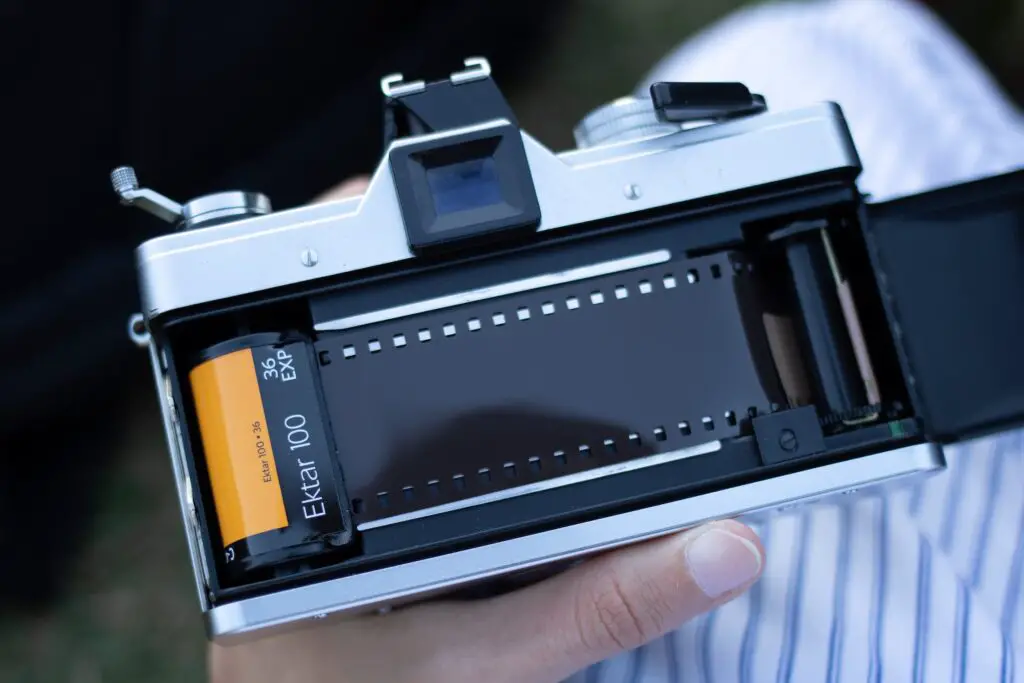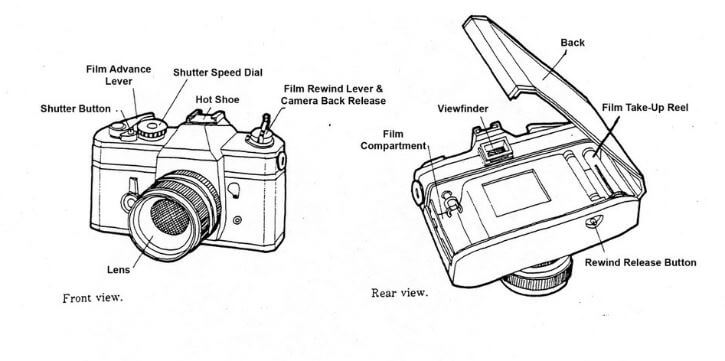Properly loading film into your film camera can mean the difference between a blank roll of film or the negatives have useable images. So, how do you know if you loaded your film correctly onto the camera?
3 ways to know if you loaded the film into your camera correctly are:
- The film take up lever spins when you use the film advance lever or wheel
- There is tension when you use the film advance lever or wheel
- The film counter changes when the film advance lever or wheel is used
These three things will tell you that the film take up spool and sprockets grabbed onto the leader and that the roll is advancing each time you engage the film advance lever or wheel. If you see that one or more of these signs are not present, then I recommend checking if the film is loaded properly before taking any images.
How to Load Film into a 35mm Film Camera (SLR, rangefinder, and Point and Shoot)
When loading film onto a 35mm film camera like an SLR, Rangefinder, or Point and Shoot, follow these steps:
- The first thing you have to do is to open the film camera back door. You can do this by either pulling the film rewind lever up or moving a slider on the side of the camera up.
- Next, load the film canister into the camera with the bump on the film canister facing down and push the film rewind lever back down to secure the roll in place. This keeps the roll moving when attaching film to the film take-up spool.
- Pull the film leader from the film canister until it reaches the take-up spool side of the camera, the film sprockets line up with the film counter sprocket wheel, and the film attaches correctly to the take-up spool. To attach the film to the film take-up spool, slide the film leader through the narrow slit on the take-up spool and use the notch on the take-up spool to grab onto a sprocket of the film leader to advance the film.
- Turn the film rewind lever to check that the film is securely attached to the film take-up sprocket until there is some slight tension on the film. This will help you to avoid blank film my making sure the film is attached to the film take-up spool correctly and the film will advance through the camera.
- Check if the sprockets on the take-up spool align with the notches on the film edge. Once aligned, close the film camera back door and engage the film advance lever. You should see the film rewind lever spin as you engage the film advance lever.
- Press the shutter button and use the film advance lever to see if the film is loaded correctly. If the film rewind lever spins and the film counter reads 1 then you are all set. If it doesn’t spin and/or the film counter doesn’t move then you have improperly loaded your film.
You will also notice a slight tension when engaging the film advance lever with properly loaded film versus one that was not properly loaded. If all these indicators are present, then you have correctly loaded film onto your camera.
How to Load Film in an Automatic 35mm Camera
Loading film onto an automatic 35mm camera is an easy and straightforward process by design. These are the steps to load 35m film into an automatic camera:
- Open the film camera back door and load the film canister. You can do this by moving a slider on the side of the camera either up or down.
- Pull the film leader from the film canister until it reaches the take-up spool. Depending on your camera model, you may need to attach it to the film take-up spool or just pull the film out to a specific distance indicated inside the camera.
- Close the film door until you hear a click and the camera should automatically advance the roll to the first frame. The frame counter should read 1 if the roll is loaded correctly and if there are batteries in the camera and they are in good shape.
If you see a flashing E or 0 on the film counter then it means that the film leader did not reach the take-up spool. You can open your film camera door again and pull more of the leader until it reaches the take-up spool and close the door.
Related Article: Contax G1 vs. Contax G2
Plastic 35mm Cameras and Reloadable Disposable Cameras
Plastic 35mm cameras and reloaded disposable cameras have the same loading process as SLRs, Rangefinders, and 35mm Point & Shoot counterparts. The main difference is that most plastic film cameras have a thumbwheel instead of a film advance lever.
Follow these steps to load film into a plastic or reloadable disposable 35mm film camera:
- The first thing you have to do is to open the film camera back door. You can do this by either pulling the film rewind lever up or moving a slider on the side of the camera up.
- Place the film canister inside the camera with the bump on the film canister facing down
- Press the film rewind lever back down to secure it in place.
- Pull the film leader from the film canister until it reaches the take-up spool (inserting the leader through the spool and use the notch for the film sprocket, if it has one)
- Turn the film rewind wheel until there is some slight tension on the film to check if the film is securely attached to the film take-up sprocket. This will help you to avoid blank film my making sure the film is attached to the film take-up spool correctly and the film will advance through the camera.
- Close the film camera back door until you hear a click.
- Advance the film by scrolling the thumbwheel to the right until it stops and press the shutter button and advance the film once more. You should see the film counter advance and the film rewind lever spin when using the film advance thumbwheel.
How to Load a Medium Format (120) Camera
Loading a roll of medium format film has a bit of a learning curve when you first try to do it. I suggest taking your time when loading a roll of medium format film and doing each step carefully. Follow these steps:
- The first step is open the film camera back taking out the used film spool. This empty spool will be your new take-up spool.
- Remove the film roll from the packaging and load it on the bottom of the camera and take the film leader and insert it on the notch in the take-up spool. Some photographers add a bit of strong tape to secure the film leader to the film take-up spool as an added precaution.
- Place the take-up spool on the upper part of the film back or camera and secure it in place by pushing down the film advance lever or knob (this may not be necessary depending on your model).
- Advance the film manually until you see the arrow on the film backing paper. Align the arrow on the film backing paper with the markings found on the camera (usually marked as “start” with a red arrow). Once aligned, you can close the film camera back door or, depending on your camera, reassemble the film back and attach it to the camera.
Use the film advance lever to advance the roll to the first frame. Check that both the frame counter on the camera or the film back and the frame number on the red window show the number 1. Once you see that both have the same frame number, you are all set to take images.
What Do I Do If I loaded My Film Wrong?
If you have loaded your film into your film camera wrong the good news there is an easy fix.
All you need to do is the following open up your camera in an area with low-light and that is out of direct light and make sure the loaded film is securely attached to the film take-up spool. If you find it is not, then attach the film leader sprocket to the film take-up spool and notch (if applicable) and use the rewind lever to make sure your film is securely attached before closing the camera film door or film back.
Also, when you open the film door on your camera, the camera should revert back to the “0” on the film counter so you won’t need to worry about keeping up with the number of shots you have left.
If not, then you may need to press the film release button the bottom of the camera and either pull up then push the film rewind lever or advance the film camera to reset the film released button before reloaded your film into the camera again.
How Do I Know if I Loaded My Film Correctly?
There are always indicators to know if you have loaded the film correctly onto your camera. For 35mm film cameras, the film rewind lever should spin when engaging the film advance lever, the frame counter should also indicate how many frames you have already used, and there is always tension when using the film advance lever.
For medium format cameras, the main thing to look out for is the frame number on the film backing paper. Make it a habit to compare the frame number you see on the red window with your film counter. If the frame number on the film backing paper does not change when using the film advance lever, then you’ll know the film wasn’t loaded correctly.
Can You Load 35mm Film in Daylight?
Ideally, loading your film in a low-light environment is preferred.
However, you can load your film in broad daylight because most rolls of film have extra frames before the film counter starts counting. These extra frames on the film leader are meant to be exposed to sunlight when loading film since they are what is used to make the film move through the camera. You will still have 24 or 36 frames as indicated in the canister even when these first few frames are accidentally exposed to sunlight.
are meant to be exposed to sunlight when loading film since they are what is used to make the film move through the camera. You will still have 24 or 36 frames as indicated in the canister even when these first few frames are accidentally exposed to sunlight.

Conclusion
It does take time to get used to properly loading film into a camera but once you experience blank film negatives after developing them, you’ll make sure to get it right.
Do each step carefully and do not rush loading film onto the camera and check for the 3 signs that the film is loaded correctly which are the film take up lever spins when you use the film advance lever or wheel, there is tension when you use the film advance lever or wheel, and the film counter changes when the film advance lever or wheel is used.
Also, remember to slow down that the film is loaded properly in your camera. It is better to have a few frames exposed to sunlight than lose a whole roll that ended up as a blank roll because the processes was rushed!


